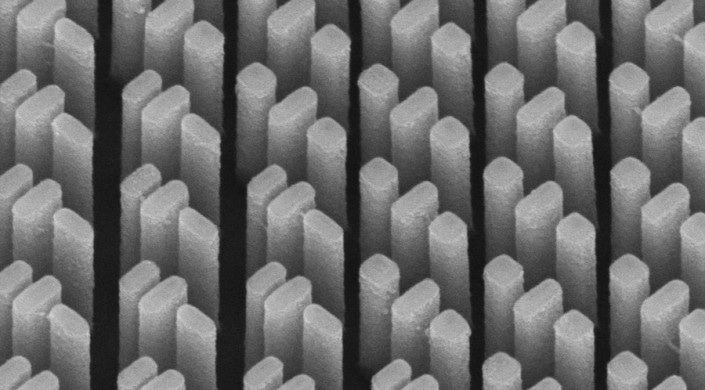Nov 21 2018
Since the mid-1700s, present-day optical systems—from smartphone cameras to advanced microscopes—use technology that hasn’t changed much. Compound lenses, which were invented around 1730, correct the chromatic abnormalities that cause lenses to focus different wavelengths of light in different spots. Although effective, these multi-material lenses are bulky, expensive, and require precision molding or polishing and very meticulous optical alignment. Currently, a team of researchers at the Harvard John A. Paulson School of Engineering and Applied Sciences (SEAS) are asking: Isn’t it time for an upgrade?
 An SEM image of the metacorrector. The refractive index of each nanopillar can be tuned and controlled so that all wavelengths are brought to the same focal point. (Image courtesy of Harvard SEAS).
An SEM image of the metacorrector. The refractive index of each nanopillar can be tuned and controlled so that all wavelengths are brought to the same focal point. (Image courtesy of Harvard SEAS).
SEAS scientists have created a so-called metacorrector, a single-layer surface of nanostructures that can rectify chromatic abnormalities across the visible spectrum and can be integrated into commercial optical systems, from basic lenses to high-end microscopes. The metacorrector eliminated chromatic abnormalities in a commercial lens across the whole visible light spectrum. The device also works for the super-complex objectives with up to 14 conventional lenses, used in high-resolution microscopes.
The study is described in Nano Letters.
“Our metacorrector technology can work in tandem with traditional refractive optical components to improve performance while significantly reducing the complexity and footprint of the system, for a wide range of high-volume applications” said Federico Capasso, the Robert L. Wallace Professor of Applied Physics and Vinton Hayes Senior Research Fellow in Electrical Engineering at SEAS and senior author of the paper.
In an earlier study, Capasso and his team showed that metasurfaces, arrays of nanopillars spaced less than a wavelength apart, can be used to control the phase, amplitude, and polarization of light and enable new, ultra-compact optical devices, such as flat lenses. This study uses the same principles to tweak and control the effective refractive index of each nanopillar so that all wavelengths are drawn by the metacorrector to the same focal point.
“You can imagine light as different packets being delivered at different speeds as it propagates in the nanopillars. We have designed the nanopillars so that all these packets arrive at the focal spot at the same time and with the same temporal width,” said Wei Ting Chen, a Research Associate in Applied Physics at SEAS and the paper’s first author.
Using metacorrectors is fundamentally different from conventional methods of aberration correction, such as cascading refractive optical components or using diffractive elements, since it involves nanostructure engineering. This means we can go beyond the material limitations of lenses and have much better performances.
Alexander Zhu, Research Co-Author and Graduate Student, SEAS
Next, the scientists aim to boost efficiency for high-end and tiny optical devices.
Harvard’s Office of Technology Development has protected the intellectual property associated with this project and is looking at commercialization opportunities.
This paper was co-authored by Jared Sisler, Yao-Wei Huang, Kerolos M. A. Yousef, Eric Lee, Harvard University and Cheng-Wei Qiu, National University of Singapore.
This study was supported by the Air Force Office of Scientific Research and the Center for Nanoscale Systems (CNS), a member of the National Nanotechnology Coordinated Infrastructure (NNCI), which is supported by the National Science Foundation.